Here, Piggy Piggy Piggy!
This week, we’ve been reading lots of pig-themed books including the ones pictured above. The book, “I know a Wee Piggy” does a great job reviewing colors by following a crazy little pig all over the fair. It’s written in the same style as “I know an old lady who swallowed a fly” and the kids loved all the pictures in this book.
We decided to recreate the wee piggy’s experience with some water-color paints. Want to follow along?
Why is crafting important for kids?
Crafting is an important activity for children as it encourages them to explore their creative potential, develop fine motor and problem-solving skills, and foster a growth mindset.
Engaging in crafting activities helps kids think actively, letting them create something unique out of raw materials.
It allows these young learners to express difficult emotions and cultivate greater independence when it comes to creating art by providing ample space for imagination. Crafting is also a great way for kids to relieve stress, and take time away from screens that can often be tiring.
Furthermore, having meaningful discussions around what they have crafted can open up various avenues of learning for children.
Ultimately, crafting poses numerous benefits that ultimately help in the physical, emotional and intellectual development of children.
What is the story of the three little pigs?
The well-known fable of the three little pigs that follows journey of three siblings as they each build their own home. The first two pigs construct dwellings out of straw and sticks respectively, but only the third pig builds his home with bricks.
A sly wolf then attempts to infiltrate each house in turn, a task he easily accomplishes at the homes made of staw and wood.
However, because the third pig has built his house with bricks, the wolf is not able to get inside and must end his pursuit of eating the pigs.
By constructing a more resilient home, the third little pig triumphs over danger, illustrating an important lesson about forethought and being prepared for life’s challenges.
What is the lesson taught in the three little pigs story?
One of the most enduring lessons to be gained from the three little pigs story is that hard work and effort can often bear greater rewards than the path of least resistance.
While the two pigs who chose to build their houses of sticks and straw respectively were able to construct their homes relatively quickly, they were not able to withstand the huffing and puffing of the big, bad wolf.
On the other hand, when building with bricks, it takes more time and effort but results in a sturdier structure which can survive all kinds of eventualities.
The moral of this timeless tale strikes with relevance in many aspects of life, as taking shortcuts is often not as beneficial as making a genuine effort to secure success.
What makes learning and drawing pigs a fun activity for kids?
Drawing and learning about pigs can be an enjoyable activity for kids, as it promotes creative expression and education.
Through the creative process of drawing pigs, children can express themselves visually and explore various topics such as biology, anatomy, and zoology.
Furthermore, beyond just physical depiction, drawing pigs encourages children to think abstractly about them as well.
They can explore questions such as “What if animals were people?” or “What qualities do I admire in my favorite farm animal?”
Through this process, a child’s imagination is opened up while they are also able to gain knowledge at the same time.
Drawing and learning about pigs is thus an enriching teaching experience that allows kids to have stimulating experiences while expressing themselves creatively.
How often should kids craft and be creative?
Engaging in creative activities is an important part of children’s development, both mentally and physically. Crafting and stimulating their imaginations helps to develop their fine motor skills, hand-eye coordination, and problem-solving capabilities, as well as strengthening their memories and imagination.
Ideally, children should craft and be creative on a regular basis. Different age groups may have different needs in this regard; depending on age, it could mean engaging in these activities a few times per week or even every day.
Furthermore, providing children with art supplies that can easily be used indoors and outdoors also helps to make sure that they are dedicating adequate time to creativity development.
When selecting supplies for the young ones however it is important to ensure that the materials are appropriate for the child’s age so that they don’t accidentally expose themselves to any potential harm.
How can I encourage my child to have confidence in their creativity?
Encouraging a child to develop confidence in their creativity is essential for their growth and development. By helping them recognize their potential and providing positive reinforcement, parents can nurture their child’s creative spirit.
Consider providing access to safe materials and opportunities for exploration, making space for them to create something special without too many expectations so that they have the freedom to express themselves in whatever way they choose.
Take time each day to ask questions about what your child has created and appreciate the process of creating something new.
It is also important to recognize the successes of your child in order to build their self-esteem and make them feel capable of taking risks while trying something new.
With the right encouragement, children will gain more trust in their own creative abilities over time.
I started by sketching a piggy. Normally, I would print off a template, but my computer is completely on the fritz and won’t even turn on, so we had to go a little archaic today!
Once it was cut out and turned around, it didn’t look so bad. Right?
The kids glued their piggy onto a sheet of green paper and the coloring began!
Usually, I put a tiny drop of water onto each water color. This eliminates the need for a glass of water. Water glasses usually get spilled around here or they usually mean way too much water on the paper and not enough color! A drop of water fixes that problem.
We read through the book a little as they colored, especially the page that reads “Upside down, he wallowed in brown”. That was their favorite line. 🙂
I know a Wee Piggy who wallowed in brown!!
Near the end of the book, the wee piggy wallowed in purple by swiping some lady’s purple scarf and running all over the fair with it. To add this to our picture, I used some purple tulle left over from Chipmunk’s birthday party.
After the kids were all done painting, I hot glued the ribbons onto the pig.
I added a “Pig” label and we hung them with pride. Chipmunk has been really excited about this project for some reason. She carried it all over the house for a day and has been showing to everyone who stops by.
What About You?
What fun pig projects have you done recently?
Lindsey Whitney is a mom of two, home day care provider and blogger over at Growing Kids Ministry. You can connect with her via twitter or on facebook.

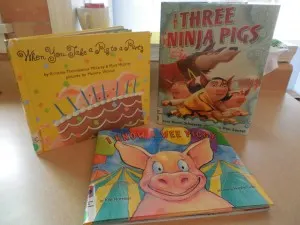
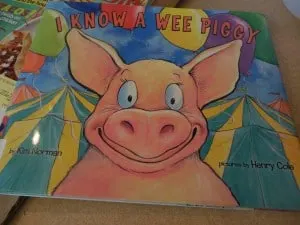
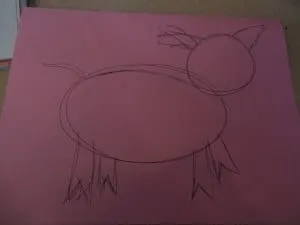
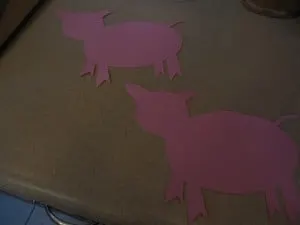
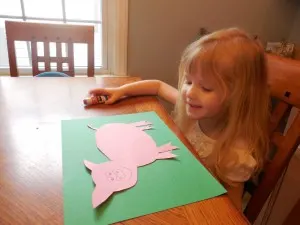
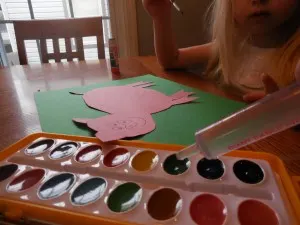
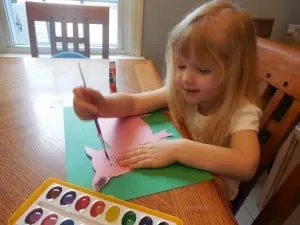
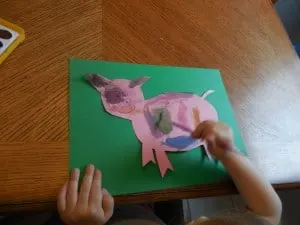
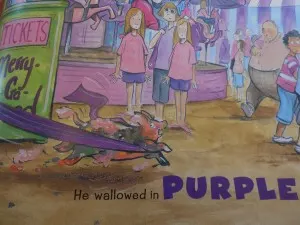
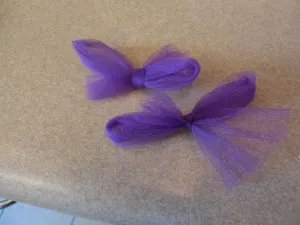
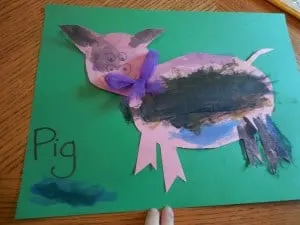
Kim Norman
Friday 26th of April 2013
Oh, and I forgot to say, "Upside down, he wallowed in brown" is a favorite line when I do school visits and read the book on a PowerPoint screen. I always have the kids say that aloud with me. It's so much fun!
Cierra
Tuesday 1st of May 2018
My students absolutely LOVE this book! I am currently working on a lesson plan using your book!
Kim Norman
Thursday 25th of April 2013
Lindsey, I'm the author of I KNOW A WEE PIGGY, and I just wanted to say thank you so much for sharing my book in such a clever way. Love the purple scarf/bow. Perfect final touch! Your daughter is much better at cutting than my sons were at that age! Keep up the lovely, creative work.
Kelli
Friday 26th of April 2013
Oh wow, thanks so much for stopping by the site! :-)